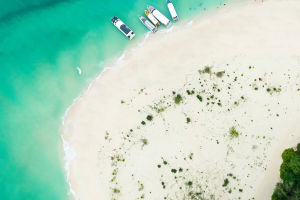The main reason for the formation of snow-capped mountains is the high altitude.
There is a pattern on the earth's surface that as the altitude rises, the air becomes thinner.
The air movement is more intense and the temperature is cooler, generally dropping by 6 degrees Celsius for every 1000 meters of rise.
If a mountain is at a high altitude like 6000 meters, it is about 36 degrees Celsius cooler than the temperature at sea level. This temperature could easily be somewhere below zero.
The temperature depends on the amount of radiation from the ground, the farther you are from the ground, the lower the temperature.
The air is thin at high altitudes and there are few substances such as water vapour and dust that can absorb solar radiation, and the scarcity of carbon dioxide.
The dust and water vapour makes them less effective in insulating the atmosphere, and ground radiation tends to dissipate, so temperatures are generally lower in high mountains.
If the height of the mountain is greater than 5,000 metres, the temperature drops below 0 degrees at the summit, so that although the foothills are hot, the summit is still covered in snow.
Snowy mountains are dangerous, so it's important to know what to do before climbing them outdoors.
The following is a summary of some of the outdoor climbing precautions.
1. Snow mountain climbing. After all, there is still a certain degree of danger, everyone should improve their preparation depending on their ability.
2. Climbing glaciers and snow slopes to be particularly cautious, glaciers on the crevasse a lot, and the greatest threat to people is the icefall area and the edge of the foothills crevasse, especially the hidden crevasse covered by snow danger.
3. When passing through crevasses, several people should move in groups, connected to each other by ropes, with a distance of 10-12 meters between two adjacent people.
4. The person who opens the path in front should always detect danger. The person behind must step on the footprints of the person in front, so that it is safer.
5. When crossing an ice bridge over a crevasse, crawl forward.
If you are only going to snowy mountains at low altitudes and can use the ropeway as a means of transport, the equipment you bring is fairly simple.
In order to enjoy the beautiful snowy peaks and alpine meadows, you only need to withstand the cold and lack of oxygen and bring an oxygen tank and a coat.
If you are an outdoor trekker, you will need much more equipment.
For example, if you go to Haba Snow Mountain in Shangri-La, the main peak is 5,396m above sea level and the upper part of the mountain is relatively gentle, while the lower part is steep and walled, you will need to prepare the following equipment.
1. Sweat-absorbent layers to wear close to the body, outdoor quick-drying thermal underwear, hiking socks, etc.
2. A warm layer, fleece jacket, and trousers, plus a light down jacket and a warm hat.
3. The outermost layer of protection, a rash guard, mid-top hiking boots, and the hiking boots must be waterproof. Warm gloves, magic bandana, snow goggles, small 20-30 liter rucksack, etc.
Mountaineering tools:
1. Helmet, headlamp, master lock (a special locking device consisting of a metal ring and a spring-loaded door that springs back. It allows quick and reversible de-linking of various components and ensures two-way locking, flat belt, and harness.
With the main lock, the flat belt, and the harness forming a descent protection system, you are not afraid even if you inadvertently make some mistakes.
Tips: Before you go, it is best to practice your stamina, so that your trip is not affected by being fully equipped and physically unable.


